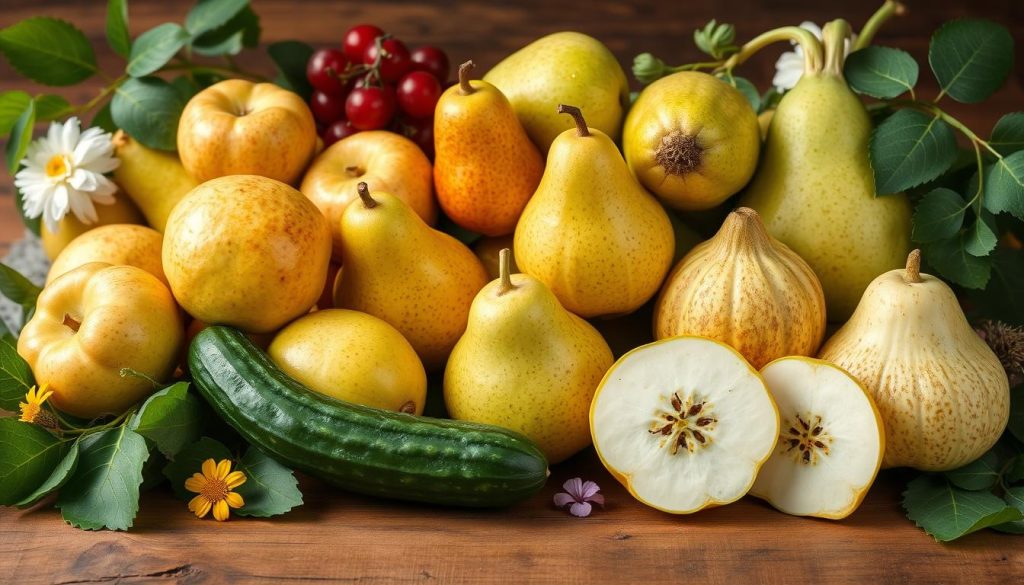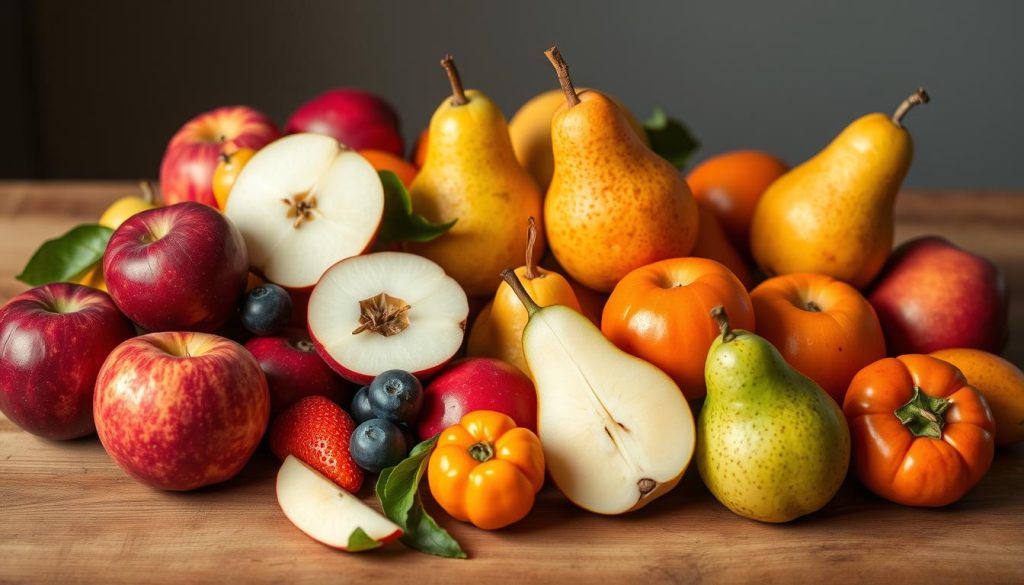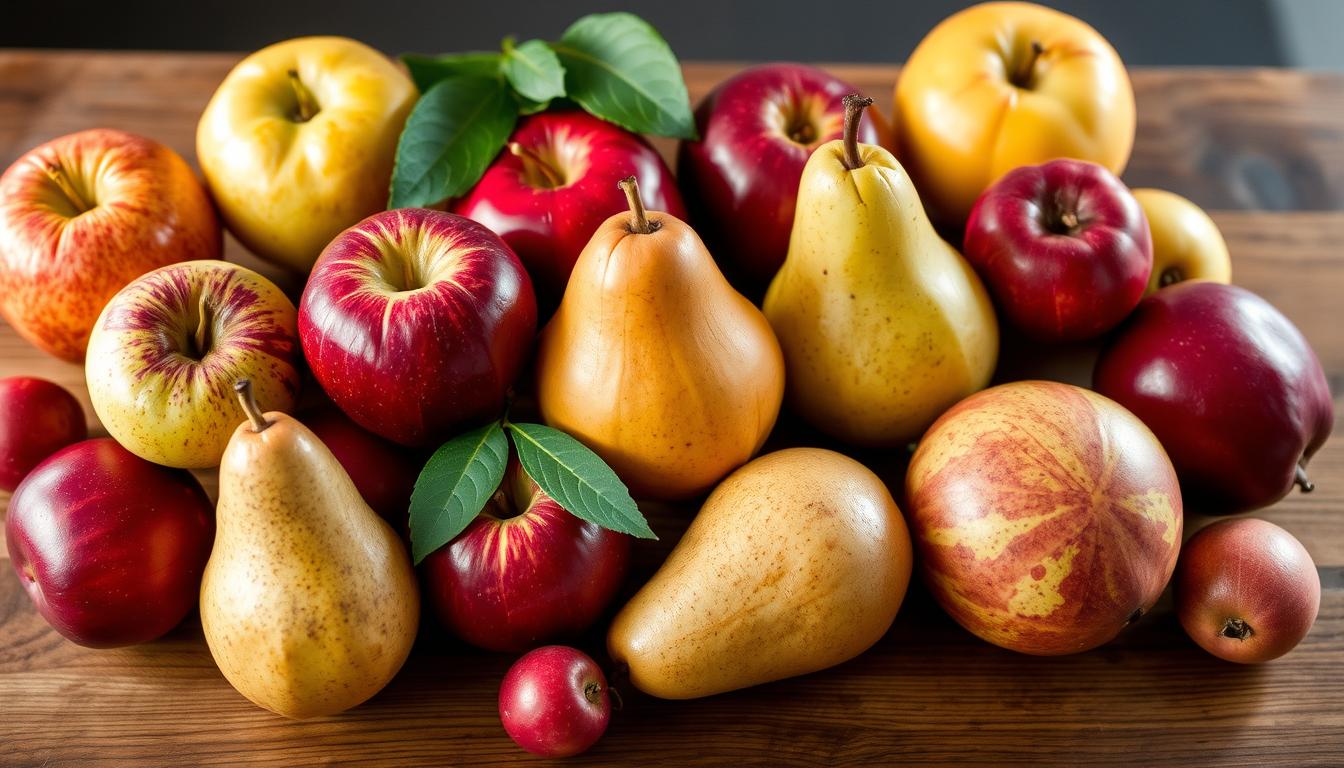Asian pears, also known as apple pears, are loved for their crispness and sweetness. They have a firm texture that stays the same even when ripe. But, finding them can be tricky, so we need good substitutes.
This guide will show you the best Asian pear alternatives. You’ll find options like Bosc pears and Fuji apples. They offer the crunch and flavor you love in Asian pears.
Learning how to substitute Asian pears is crucial. It helps keep your dishes balanced, whether it’s a salad or dessert. Let’s dive into the many options that can make your dishes even better!
Understanding Asian Pears and Their Unique Qualities
Asian pears, also known as Korean pears or Nashi pears, stand out in the fruit world. They have been grown in China for over 3,000 years. Their Asian pear texture is firm and juicy, making them great for eating raw.
Their taste is sweet with a hint of tartness. The unique structure of Asian pears, thanks to stone cells, gives them a gritty feel.
Texture and Flavor Profile
The Asian pear flavor is special, blending sweet and slightly tart notes. Varieties like Hosui and Chojuro have golden-brown skin and juicy, fine-grained flesh. Unlike European pears, Asian pears stay crisp as they ripen.
This makes their Asian pear texture ideal for refreshing dishes and snacks.
Usage in Culinary Dishes
Asian pears are versatile in cooking. Their crunchy texture adds excitement to salads and enhances stir-fries. They pair well with both sweet and savory flavors.
They can also be used in desserts, where their natural sweetness complements other flavors. As Asian pear popularity grows, you’ll find more ways to use them in your cooking.
Why You Might Need a Substitute for Asian Pear
Asian pears can be hard to find, mainly outside their peak season. Many stores don’t always have them in stock. This makes finding alternatives necessary. Also, some people might have pear allergies, which means they need safe substitutes for cooking.
Availability Issues
Asian pears are not always easy to find, depending on where you live. Stores might not have them, or they might be out of season. This makes it important to look for other fruits that taste and feel similar.
Dietary Preferences and Allergies
Some people might need to avoid pears due to allergies or dietary restrictions. Finding safe alternatives is key. You can find fruits that taste and feel like pears but are safe for those with allergies.
Top Fruits to Use as Substitutes for Asian Pear
Looking for a good substitute for Asian pear can really boost your dish’s taste and texture. Many fruits can replace Asian pears well, offering similar qualities. Here are some top picks for substitutes.
Bosc Pears
Bosc pears have a dense flesh with a spicy hint. They’re great as a substitute for Asian pears. Their strong, earthy taste adds a unique flavor to your recipes, making them sweeter.
Fuji Apples
Fuji apples are known for their crispness and sweetness. They work well in dishes like salads and cooked meals. Their slight tartness adds a nice tang, improving your dish’s overall taste.
Nashi Pears
Nashi pears are almost the same as Asian pears, with a similar crunch and mild sweetness. They stay refreshing due to their high water content. This makes them a simple and effective substitute for Asian pears in many recipes.
Vegetable Alternatives to Asian Pear
Looking for a substitute for Asian pear? Jicama and water chestnuts are great choices. They add a nice crunch and don’t overpower other flavors. You can use them 1:1 in recipes, making them easy to add to your cooking.
Jicama
Jicama, also known as Mexican turnip, is sweet and crunchy. It’s perfect for salads or slaws. Slice it thinly or julienne it to add a unique touch to your dishes.
Water Chestnuts
Water chestnuts add crunch and a mild taste. They’re great in stir-fries and salads. They bring a new texture and flavor without taking over.

How to Use the Best Substitutes in Cooking
Using the right substitutes in your cooking can make your dishes truly special. When you’re cooking with Asian pear substitutes, you might need to tweak your methods a bit. This ensures the texture and flavor stay just right. Here are some tips for using substitutes in different types of meals.
In Salads
For salads, try using Fuji apples or Honeycrisp apples. They add a nice crunch and a touch of sweetness. If you want something different, jicama is a great choice. You can swap out Asian pears with these options at a 1:1 ratio for a fresh twist.
In Stir-Fries
In stir-fries, water chestnuts and Bosc pears are top picks. They keep their crunch, blending well with other flavors. Use them in the same amount as Asian pears for the right texture. Remember, adjusting cooking times is key to keep them tender but still crisp.
For Baking
In baking, Anjou pears and Fuji apples are perfect. They’re moist and sweet, just like Asian pears. You can use them in the same amount in recipes where baking sweetens them up, making the dish moist and tasty.
| Dish Type | Best Substitutes | Replacement Ratio |
|---|---|---|
| Salads | Fuji Apples, Honeycrisp Apples, Jicama | 1:1 |
| Stir-Fries | Water Chestnuts, Bosc Pears | 1:1 |
| Baking | Anjou Pears, Fuji Apples | 1:1 |
By following these tips, you can make your dishes even better. Remember, experimenting with different textures and flavors is part of the fun. Try out these substitutes and see how they can enhance your cooking.
Substitute for Asian Pear Guide: Finding the Right Match
Choosing the right substitute for Asian pears is all about texture and sweetness. Each fruit has its own unique taste and feel. Knowing how they compare is key to getting the flavor you want in your dishes.
Choosing Based on Texture
Texture is important when picking a substitute for Asian pears. For a crunchy bite, Bosc pears and Fuji apples are great. They are firm and hold up well in cooking.
Honeycrisp apples offer a refreshing crunch and a sweet-tart taste. Here’s a quick look at how these fruits compare to Asian pears:
| Fruit | Texture | Application |
|---|---|---|
| Bosc Pears | Firm and dense | Best for baking and cooking |
| Fuji Apples | Similar to Asian pears; slightly softer | Great in salads |
| Honeycrisp Apples | Satisfying crunch | Refreshing in raw dishes |
Choosing Based on Sweetness
Sweetness is crucial when finding a substitute for Asian pears. Bartlett pears are sweeter, with a buttery texture and juicy taste. Comice and Anjou pears also offer rich flavors that can enhance your recipes.
Finding the right balance of sweetness is important. It helps create dishes that match your expectations of Asian pears. Here’s a quick comparison of these fruits:
| Fruit | Sweetness Level | Flavor Notes |
|---|---|---|
| Bartlett Pears | High | Juicy, buttery |
| Comice Pears | Very high | Succulent, aromatic |
| Anjou Pears | Medium-High | Sweet, smooth |
| Granny Smith Apples | Medium | Crisp, slightly acidic |

Other Creative Substitutes You Might Not Have Considered
Looking for creative substitutes for Asian pears? Consider applesauce and pineapple. Each offers unique benefits for your recipes.
Using Applesauce
Applesauce is a versatile ingredient. It’s not as crunchy as Asian pears but adds moisture and sweetness. It’s great in baked goods like muffins and cakes, replacing fat and adding flavor. Just remember to adjust the liquid in your recipe for the best results.
Experimenting with Pineapple
Pineapple adds a refreshing twist to dishes. Its juicy and sweet-tart flavor is perfect for salads and stir-fries. Be careful not to use too much, as it can overpower the dish. Finding the right balance will help you enjoy a dish with great harmony.
| Substitute | Texture | Flavor Profile | Best Uses |
|---|---|---|---|
| Applesauce | Moist | Sweet | Baking, smoothies |
| Pineapple | Juicy | Sweet-tart | Salads, stir-fries |
Conclusion
Finding Asian pear substitutes is easy with many options. You can use Bosc pears for their dense flesh or Fuji apples for their sweet crunch. Nashi pears also have similar qualities, making your dishes great without losing quality.
Try Honeycrisp or Granny Smith apples for a fresh twist. They add unique textures and flavors to your recipes. Anjou and Comice pears are also sweet, perfect for cooking and snacking.
Knowing these substitutes lets you adjust your cooking style. This way, you can enjoy your meals just as you like, even without Asian pears. Start exploring these options in your cooking and enjoy the journey!
Source Links
- https://casadesante.com/blogs/wellness/best-asian-pear-substitutes?srsltid=AfmBOopdDgBZUKvLaMJsQdJYxItZvagr_3M8g38c360LOQCHOUibC0EC
- https://bayevskitchen.com/asian-pear-substitutes/
- https://journals.ashs.org/hortsci/view/journals/hortsci/51/11/article-p1325.xml
- https://www.phillyorchards.org/2022/09/09/plant-spotlight-the-auspicious-asian-pear/
- https://veritablevegetable.com/welcome-asian-pear-season/
- https://www.alsothecrumbsplease.com/asian-pear-substitute/
- https://casadesante.com/blogs/wellness/best-asian-pear-substitutes?srsltid=AfmBOorOMKdHc_eEQLfc9ntUVRf5ejGU8qgNpU5D93FIGisljsOIWXNO
- https://casadesante.com/blogs/wellness/best-asian-pear-substitutes?srsltid=AfmBOor0d0jUEjouXQ9fr77lFO_zXrnl7Cw7V73Zr9xQFhD2NPNRIaSO
- https://pestoandmargaritas.com/substitutions-for-pears/
- https://casadesante.com/blogs/wellness/best-asian-pear-substitutes?srsltid=AfmBOorprlw6_8KvKVVVx3l4HXQ55SBxnNu3-gENJII-0shTV44fOJUt
- https://artdefete.com/best-substitutes-for-asian-pears/
- https://casadesante.com/blogs/wellness/best-asian-pear-substitutes?srsltid=AfmBOorj7J9MExSi3NjuHUsqIWXLQWKR_grJ5GxHyYgQOn45tgNKFCcR
- https://ask.metafilter.com/369429/Asian-ingredient-substitution-list
- https://casadesante.com/blogs/wellness/best-asian-pear-substitutes?srsltid=AfmBOorW1ipcC21FKCtAWaZ0ObKevwm0_5tDoSx-7J8xXer7bqWzmRsq
- https://veritablevegetable.com/pear-variety-guide/
- https://www.thekitchn.com/steamed-asian-pear-recipe-23229877
- https://casadesante.com/blogs/wellness/best-asian-pear-substitutes?srsltid=AfmBOooStVNB4LRDjFEoRMyvbYMd6fM8HOpa5BFBMHcik-bX0Up5P0oc
- https://www.castironketo.net/friendly/plants/fruits/pomes/asian-pears/
- https://villettt.kitchen/steamed-asian-pear/
- https://casadesante.com/blogs/wellness/best-asian-pear-substitutes
- https://journals.ashs.org/hortsci/downloadpdf/journals/hortsci/51/11/article-p1325.xml
